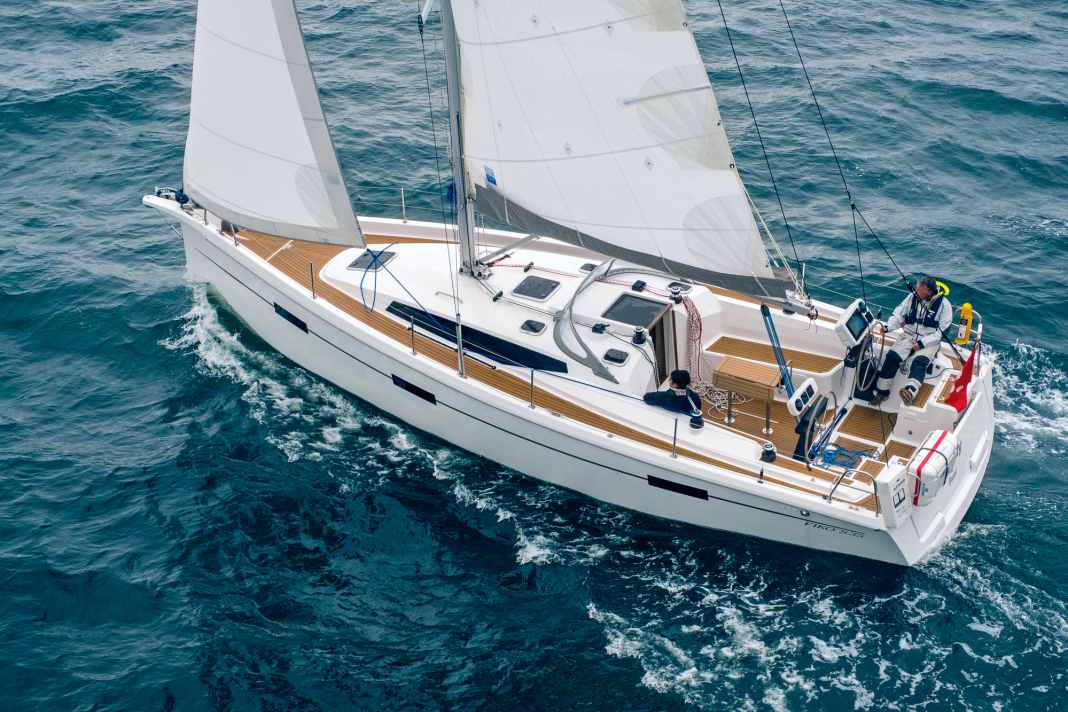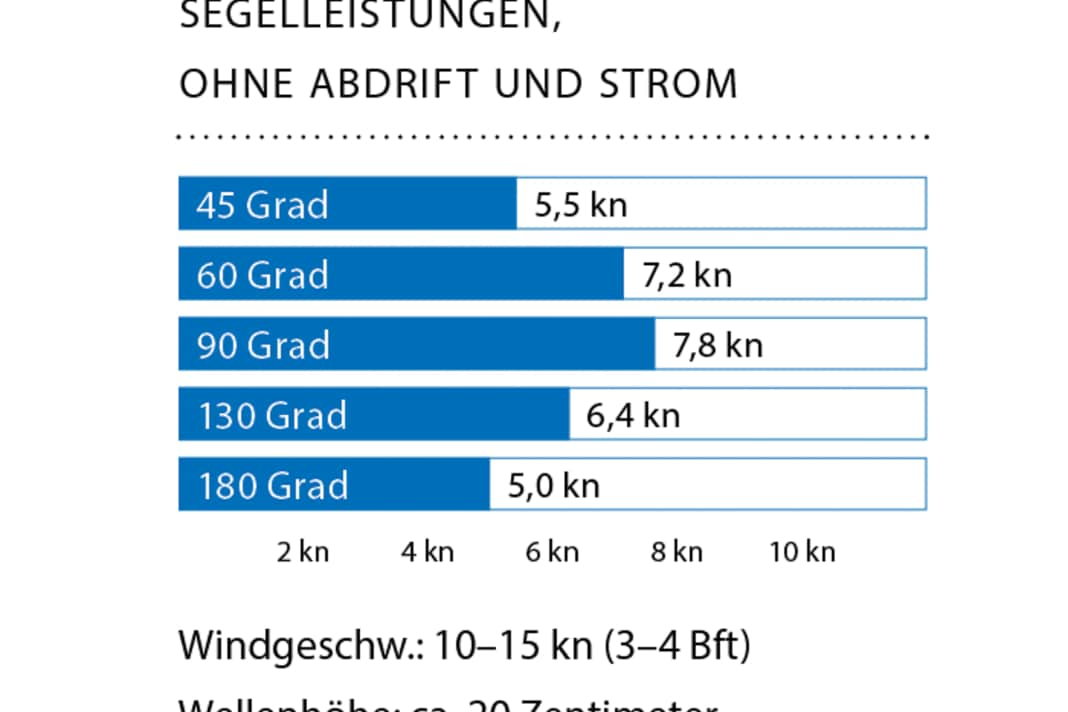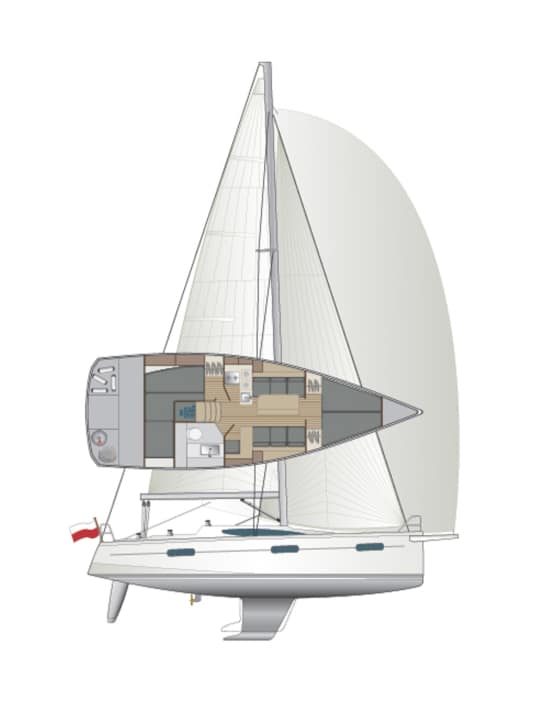





More than a year between the initial presentation and the YACHT test is an unusually long and very rare period of time; our test drives usually take place even before our trade fair appearances. In this case, a fire at the Polish shipyard in between - and a certain fear on the part of the management of poor results. They wanted to present the ship that was really ready for series production first, they said.
This was now available to us in two versions: one freshly delivered and not yet fully equipped at the dealer Yachthandel Hamburg and another edition ready to sail in the owner's hands and fully equipped in the Ancora Marina in Neustadt, Schleswig-Holstein. A Viko S 35, which is even larger than the 10.7 metres that 35 feet means. The boat is 10.88 metres long in the hull. This means that types such as the Elan 4 (10.60 metres), the Bavaria 37 (10.90 metres), the Sun Odyssey 389 (10.98 metres) and the Hanse 388 (10.99 metres) are suitable for direct comparison.
The competition
- Exclusive photos of the Bavaria Cruiser 37 from 2013
- Hanse 388: The easy-to-sail cruising yacht put to the test
- Sun Odyssey 380: The all-rounder from France in the test
What makes them special
Characteristic number one was already evident at the trade fair and even more so at the two local test dates: the new boat looks very pleasing and has modern, racy lines. Designer Sergio Lupoli even managed to breathe individuality into the boat: Deep chines up to the mast, a concave transom shape in the stern area and a raised foot rail as a continuation of the freeboards, which already pass for a small bulwark, give the boat a unique look. Another striking feature is the oversized and quite deep cockpit. The thwarts are 1.55 metres long and are between 1.15 and 1.43 metres apart. This makes a support option in the centre mandatory, which is provided by a fairly short folding table.
It costs extra, and here it starts, the long list of options that are not included but are as useful as they are desirable. The thwarts are 40 centimetres above the cockpit floor, which is fine, but the coaming is another 44 centimetres high. On the one hand, the crew sits very protected and almost sheltered, but has to overcome a greater height difference to leave the cockpit, and smaller co-sailors even find it difficult to crank the halyard winches.
The helmsman also stands quite low on the two 80-centimetre wheels, which have now been included in the standard scope of delivery. Their upper edges rise just under 1.30 metres above the cockpit floor. This still fits the average German man and is then at about sternum height. For the average woman, however, the wheel is already quite high. However, if you stand a little further out, where you can see the wind lines better, you will find a comfortable working position. Sitting sideways on the coaming, one leg dangles in the air; a folding support would make sense to retrofit here.
What is striking is the endeavour of the shipyard and designer to create an appealing design, even for supposedly simple components such as coamings, dents or superstructure. Chamfers and edges break up large shapes and surfaces, which looks good and gives the impression of quality. However, the kinks in the superstructure bulkhead on both sides of the companionway prevent cosy leaning, as is often the case there.
In terms of handling, the boat is hardly inferior to the competition apart from the high halyard winches. 40 mm winches, optionally from Lewmar or Harken (surcharge), are typical of the class, a pin stop for adjusting the centre of gravity is acceptable, and a traveller on the cockpit floor is welcome. At 4:1, the mainsheet on the yard side is too weak; a more powerful tackle with two gears was installed on the test boat (extra charge).
How she sails
The look is pleasing, the handling okay: what about the sailing characteristics? The Viko S 35 is equipped with a 13.5 metre long mast as standard, on which around 51 square metres of cloth are used. This and the weight of 6.1 tonnes result in a sail load factor of 3.9, which is very low. This assessment is confirmed in light winds. 5.5 knots and a 90-degree tacking angle at 3 to 4 Beaufort are values that identify the boat as a pure cruising yacht. If the wind becomes even weaker, the speed drops to under five knots and the boat, which otherwise steers quite neutrally, tends to lean.
How it can be tuned
Quite different on rough courses and a little more breeze. As soon as it drops, the boat sprints off well and is a lot of fun to sail. And you can have fun even in less wind. Firstly, the standard sails are not optimised in terms of surface area, so any sailmaker can add a few more square metres. And for a comparatively small surcharge, the customer receives a 1.5 metre longer mast and around twelve square metres larger sails. This measure boosts the sail carrying capacity to 4.3 and is certainly also recommended for family crews.
Tuning is also possible and advisable for the engine. The standard unit has 15 hp and delivers 13.6 hp output. This is nominally only 2.5 hp per tonne, which will not be enough in short waves, strong winds or strong currents. An optional 30 hp is also available from Yanmar. This gives a cruising speed of 7 knots, whereby the noise level in the aft cabin and cockpit exceeds 80 decibels(A), which is considered loud. The larger engine catapults the price upwards, and the recommended three-bladed folding prop adds to this. What is also striking in this context is that the furling system is also an extra.
The bathing platform is also not included, but neither is it with some large series manufacturers. The bowsprit is also included.
What characterises them inside
The interior is surprising. The design is quite simple and open, hull windows and four small and two large deck hatches (all standard) are pleasing. The interior is finished with imitation wood-coated marine plywood, a material mix that is considered to be very durable. A comparison of the two Viko S 35s inspected revealed quite large differences in the wood finish, which appeared quite rough in places.
The aft berth of the two-cabin version is special. Although it is large, it is quite flat under the deep cockpit floor and extends to the starboard side, where the aft cabin opens upwards under the coaming into an unused space. The Swiss owner had a watertight hatch installed in the dinghy and can thus use the area as a forecastle open to the cabin.
The storage space is large, partly because most of the space under all the berths can be used - the tanks are quite small at 145 litres for fresh water (in a bag) and 65 litres for the engine. The same applies to the power capacity: the only battery in the standard version has a capacity of 60 ampere hours.
All in all, the boat is very sparsely equipped. The basic price includes the necessary basics such as a compass, refrigerator and holding tank. Equipped with the comfort package defined by YACHT (including items such as teak in the cockpit, instruments, autopilot, shore connection, hot water and heating), the purchase costs rise again. And things that the competition usually already includes cost extra: cockpit table, stronger mainsheet, more cloth, a normally powerful engine, furling system and bathing hatch. However, you can start low with this boat and then gradually upgrade the amenities.
The measured values for testing the Viko S 35




The Viko S 35 in detail

Technical data of the Viko S 35
- Designer:Sergio Lupoli
- CE design category:A/B
- Torso length:10,88 m
- Waterline length:10,00 m
- Width:3,74 m
- Draught/alternative:1,95/1,60 m
- Weight:6,1 t
- Ballast/proportion:2,0 t/33 %
- sail area:51,45 m2
- machine (Yanmar):11 kW/15 hp
Hull and deck construction
Hand lay-up method. Hull full laminate, deck foam sandwich. Bulkheads laminated to hull and deck
Price
- Base price ex shipyard: 115,990 euros incl. VAT
- Warranty/against osmosis: 2/2 years
Prices as of 09/2023, as the prices shown are defined, you will find here !
Shipyard
Viko Yachts, Poland
Distribution
Yachthandel Hamburg; www.yachthandel-hamburg.de
YACHT rating of the Viko S 35
The Viko S 35 looks hotter than it is with the standard rig. It offers a very large cockpit, but this reduces the size of the aft cabin. The basic price is very favourable, but the equipment is still quite limited
Design and concept
- + Modern, appealing design
- + Favourable entry into the class
- + Two rig sizes
- -/+ Cockpit very deep, but large
Sailing performance and trim
- - Standard rig tight for light winds
Living and finishing quality
- + Large bunks
- + Plenty of storage space
- - Woodworking quite heterogeneous
Equipment and technology
- + Durable finishing material
- - Small machine as standard
- - Small tanks as standard
This article first appeared in YACHT 13/2020 and has been revised for this online version.

